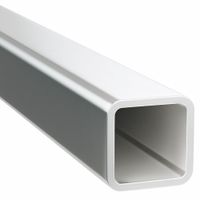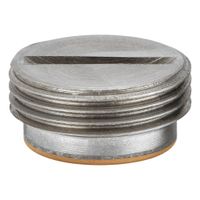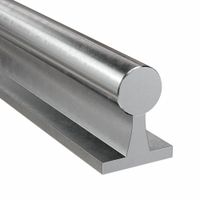Call +(254) 703 030 000 / 751 483 999 / 721 704 777
- Home
- Power Transmission
- Linear Motion
- Precision Linear Shafts
.....Read More
Frequently Asked Questions
What are the key differences between linear round shafts and linear square shafts?
Linear round shafts and linear square shafts differ primarily in shape, which affects their performance, application, and installation.
1. **Shape and Design**:
- **Round Shafts**: Cylindrical in shape, allowing for smooth rotational movement. They are typically used in applications where rotation or sliding is required.
- **Square Shafts**: Have a square cross-section, providing better resistance to twisting and higher torque transmission.
2. **Load Capacity**:
- **Round Shafts**: Generally have a lower load capacity compared to square shafts due to their shape, which can lead to bending under heavy loads.
- **Square Shafts**: Offer higher load capacity and resistance to bending, making them suitable for applications with higher stress.
3. **Alignment and Installation**:
- **Round Shafts**: Easier to align and install due to their symmetrical shape. They can be used with a variety of linear bearings and bushings.
- **Square Shafts**: Require precise alignment and installation. They are less forgiving of misalignment, which can lead to increased wear.
4. **Applications**:
- **Round Shafts**: Commonly used in applications like printers, CNC machines, and other equipment where smooth, linear motion is needed.
- **Square Shafts**: Used in applications requiring high torque and rigidity, such as in heavy machinery and structural components.
5. **Cost and Manufacturing**:
- **Round Shafts**: Generally easier and cheaper to manufacture due to their simple geometry.
- **Square Shafts**: More complex to manufacture, potentially leading to higher costs.
6. **Material and Surface Finish**:
- Both types can be made from similar materials, but the surface finish may vary based on application requirements, affecting friction and wear characteristics.
These differences dictate their suitability for specific applications, with round shafts favoring rotational and sliding applications, while square shafts are preferred for high-load, high-torque scenarios.
How do I choose the right linear shaft for my application?
To choose the right linear shaft for your application, consider the following factors:
1. **Load Requirements**: Determine the maximum load the shaft will support. This includes both static and dynamic loads. Choose a shaft with sufficient strength and rigidity to handle these loads without excessive deflection.
2. **Material**: Select a material based on environmental conditions and load requirements. Common materials include carbon steel, stainless steel, and aluminum. Stainless steel is ideal for corrosive environments, while carbon steel offers high strength.
3. **Diameter and Length**: The shaft diameter should be large enough to support the load without bending. Length should be appropriate for the application, considering any space constraints and the need for overhang.
4. **Surface Finish**: A smooth surface finish reduces friction and wear, enhancing the shaft's lifespan. Consider precision-ground shafts for applications requiring high accuracy and smooth motion.
5. **Tolerances**: Ensure the shaft's dimensional tolerances match the requirements of your application, especially if it will be used with linear bearings or bushings.
6. **Mounting and Support**: Consider how the shaft will be mounted and supported. Proper support is crucial to prevent sagging and ensure smooth operation. Options include end supports, shaft supports, and continuous support along the length.
7. **Environmental Conditions**: Consider factors like temperature, humidity, and exposure to chemicals. Choose materials and coatings that can withstand these conditions without degrading.
8. **Cost and Availability**: Balance performance requirements with budget constraints. Consider the availability of the shaft in the required specifications and any lead times for custom orders.
9. **Application-Specific Requirements**: Consider any additional requirements specific to your application, such as speed, precision, or compatibility with other components.
By evaluating these factors, you can select a linear shaft that meets the functional, environmental, and economic needs of your application.
What are the benefits of using ball spline linear shafts?
Ball spline linear shafts offer several benefits:
1. **High Load Capacity**: Ball splines can support heavy loads due to the even distribution of forces across multiple contact points. This makes them suitable for applications requiring high load-bearing capabilities.
2. **Smooth Linear Motion**: The rolling motion of the balls within the spline provides smooth and precise linear movement, reducing friction and wear compared to traditional sliding mechanisms.
3. **High Torque Transmission**: Ball splines can efficiently transmit torque while allowing for linear motion, making them ideal for applications that require simultaneous rotational and linear movements.
4. **Reduced Friction**: The rolling contact of the balls minimizes friction, leading to less heat generation and wear, which extends the lifespan of the components and reduces maintenance needs.
5. **High Rigidity and Accuracy**: The design of ball splines ensures high rigidity and accuracy, maintaining alignment and precision in applications that demand tight tolerances.
6. **Compact Design**: Ball spline shafts are compact, allowing for space-saving designs in machinery and equipment without compromising performance.
7. **Versatility**: They are versatile and can be used in various applications, including robotics, automation, and CNC machinery, where precise linear and rotational movements are essential.
8. **Corrosion Resistance**: Many ball spline shafts are made from materials that resist corrosion, making them suitable for use in harsh environments.
9. **Easy Installation and Maintenance**: Ball splines are relatively easy to install and maintain, with replaceable components that simplify repairs and reduce downtime.
10. **Vibration Damping**: The design can help in damping vibrations, leading to quieter operation and improved performance in dynamic applications.
How do I properly maintain and lubricate linear shafts and bearings?
To properly maintain and lubricate linear shafts and bearings, follow these steps:
1. **Inspection**: Regularly inspect the shafts and bearings for signs of wear, corrosion, or damage. Check for misalignment and ensure that the components are securely mounted.
2. **Cleaning**: Clean the shafts and bearings to remove dust, dirt, and debris. Use a lint-free cloth and a suitable solvent or cleaner that does not leave residues. Avoid using water unless the components are specifically designed to be water-resistant.
3. **Lubrication**: Choose the appropriate lubricant based on the manufacturer's recommendations. Common options include oil, grease, or dry lubricants. Consider the operating environment, load, speed, and temperature when selecting a lubricant.
4. **Application**: Apply the lubricant evenly along the shaft and into the bearings. For oil, use a dropper or oil can to apply a thin film. For grease, use a grease gun or apply manually with a brush or spatula. Ensure that the lubricant reaches all moving parts.
5. **Frequency**: Establish a lubrication schedule based on usage and environmental conditions. High-speed or high-load applications may require more frequent lubrication. Follow the manufacturer's guidelines for specific intervals.
6. **Avoid Over-lubrication**: Excessive lubrication can attract contaminants and cause overheating. Apply only the necessary amount to ensure smooth operation.
7. **Environmental Considerations**: Protect the components from harsh environments by using seals or covers. In dusty or corrosive environments, consider using lubricants with additives that provide additional protection.
8. **Record Keeping**: Maintain a log of maintenance activities, including inspection dates, cleaning, and lubrication. This helps in tracking performance and scheduling future maintenance.
By following these steps, you can ensure the longevity and optimal performance of linear shafts and bearings.
What factors affect the load capacity of linear shafts and guides?
The load capacity of linear shafts and guides is influenced by several factors:
1. **Material Composition**: The material used for the shaft and guide, such as steel, aluminum, or composite materials, affects their strength, rigidity, and wear resistance, directly impacting load capacity.
2. **Diameter and Cross-Section**: Larger diameters and optimized cross-sections increase the moment of inertia, enhancing the shaft's ability to withstand bending and torsional loads.
3. **Length of the Shaft**: Longer shafts are more prone to deflection under load, reducing load capacity. Shorter shafts provide better support and higher load capacity.
4. **Support and Mounting**: The type and number of supports (e.g., end-supported, fully supported) influence the load distribution and deflection characteristics, affecting load capacity.
5. **Bearing Type and Configuration**: The type of bearings (e.g., ball, roller, plain) and their arrangement (e.g., linear, crossed) determine the friction, load distribution, and overall capacity.
6. **Surface Finish and Hardness**: A smoother surface finish reduces friction and wear, while higher surface hardness improves resistance to deformation and wear, enhancing load capacity.
7. **Alignment and Installation**: Proper alignment and installation prevent uneven load distribution and excessive wear, maintaining optimal load capacity.
8. **Operating Conditions**: Environmental factors such as temperature, humidity, and exposure to corrosive substances can affect material properties and lubrication, impacting load capacity.
9. **Dynamic vs. Static Loads**: The nature of the load (dynamic or static) influences the fatigue life and load capacity, with dynamic loads typically reducing capacity due to cyclic stresses.
10. **Lubrication and Maintenance**: Adequate lubrication reduces friction and wear, while regular maintenance ensures optimal performance and load capacity over time.
How do I install and align linear shafts and support rails?
1. **Preparation**: Gather necessary tools such as a spirit level, calipers, wrenches, and a straightedge. Ensure the mounting surface is clean and flat.
2. **Positioning**: Place the support rails on the mounting surface. Use a straightedge to ensure they are parallel. Mark the mounting holes on the surface.
3. **Drilling**: Drill holes at the marked positions. Ensure the holes are perpendicular to the surface to avoid misalignment.
4. **Mounting Rails**: Secure the support rails using screws or bolts. Use a spirit level to ensure they are level. Tighten the fasteners gradually and evenly to avoid distortion.
5. **Placing Shafts**: Position the linear shafts onto the support rails. Ensure they are parallel to each other and the rails.
6. **Alignment**: Use calipers to measure the distance between the shafts at multiple points along their length. Adjust as necessary to maintain consistent spacing.
7. **Securing Shafts**: Once aligned, secure the shafts using shaft clamps or end supports. Tighten evenly to prevent shifting.
8. **Verification**: Recheck alignment using a straightedge and calipers. Ensure the shafts are parallel and level.
9. **Testing**: Slide a linear bearing or carriage along the shafts to ensure smooth movement without binding.
10. **Final Adjustments**: Make any necessary adjustments to the alignment or tension of the fasteners.
11. **Maintenance**: Regularly check alignment and retighten fasteners as needed to maintain performance.
What are the common materials used for linear shafts and their advantages?
Common materials used for linear shafts include:
1. **Carbon Steel**:
- **Advantages**: High strength, durability, and cost-effectiveness. It is suitable for applications requiring high load capacity and wear resistance.
2. **Stainless Steel**:
- **Advantages**: Corrosion resistance, making it ideal for environments exposed to moisture or chemicals. It also offers good strength and wear resistance.
3. **Aluminum**:
- **Advantages**: Lightweight, corrosion-resistant, and easy to machine. It is suitable for applications where weight reduction is crucial.
4. **Chromed Steel**:
- **Advantages**: Combines the strength of steel with a chrome plating for enhanced surface hardness and corrosion resistance. It provides a smooth surface finish, reducing friction and wear.
5. **Tool Steel**:
- **Advantages**: High hardness and wear resistance, making it suitable for high-precision applications. It maintains its properties at elevated temperatures.
6. **Titanium**:
- **Advantages**: High strength-to-weight ratio and excellent corrosion resistance. It is used in aerospace and medical applications where weight and biocompatibility are critical.
7. **Composite Materials**:
- **Advantages**: Customizable properties, including high strength and low weight. They offer excellent corrosion resistance and can be tailored for specific applications.
Each material offers unique benefits, making them suitable for different applications based on factors like load capacity, environmental conditions, and cost considerations.





